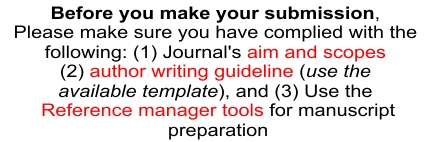HUBUNGAN TINGKAT PENDIDIKAN DAN PARITAS DENGAN PEMILIHAN ALAT KONTRASEPSI BAWAH KULIT PADA PASANGAN USIA SUBUR DI DESA SUKABUMI
Abstract
Background: Under-skin contraceptives (AKBK) are effective and efficient hormonal contraceptives in the form of rods implanted under the skin, namely the upper arm and the protection period can reach five years. Education level and parity are factors that affect the selection of under-skin contraceptives. The level of education is one of the factors that greatly determines a person's knowledge and awareness of the importance of something, including the importance of participating in effective family planning such as under-skin contraceptives. High parity in couples of childbearing age has a tendency to use under-skin contraceptives. Research objectives: This study aims to find out whether there is a relationship between education level and parity with the selection of under-skin contraceptives in couples of childbearing age in Sukabumi village. Methods: This study was conducted using the Cross Sectional method with a population of couples of childbearing age who used contraceptives in Sukabumi Village totaling 627 people as of 2023 with a sample of 86 people through purposive sampling. The analysis test uses the Chi-Square statistical test with a confidence degree of 95% (? < 0.05). Results: From the results of the Chi - Square test , the education level of p-value 0.009 < 0.05 and the parity of p-value 0.000 < 0.05 were obtained. Conclusion: There is a relationship between education level and parity with the selection of under-skin contraceptives in couples of childbearing age in Sukabumi village. Keywords : AKBK, education level, parityReferences
BKKBN. (2017). Profil Keluarga Indonesia. Jakarta: BKKBN.
BKKBN, Jawa Tengah. (2021). Jumlah Pasangan Usia Subur (PUS) dan Peserta KB Aktif Menurut Kabupaten/Kota di Provinsi Jawa Tengah (Jiwa),. Jumlah Pasangan Usia Subur (PUS) dan Peserta KB Aktif Menurut Kabupaten/Kota di Provinsi Jawa Tengah (Jiwa),.
BKKBN. (2013). Pemantauan Pasangan Usia Subur Melalui Mini Survei Indonesia. Pemantauan Pasangan Usia Subur Melalui Mini Survei Indonesia.
BKKBN. (2014). Buku saku bagi petugas lapangan program KB Nasional. Jakarta: BKKBN.
BKKBN. (2015). Rencana Strategis Badan Kependudukan dan Keluarga Berencana Nasional Tahun 2015-2019. Jakarta: BKKBN.
BKKBN. (2017). Profil Keluarga Indonesia. Profil Keluarga Indonesia.
BKKBN. (2019). Jurnal Keluarga Informasi Kependudukan, KB, Dan Pembangunan Keluarga. Jurnal Keluarga, 1-3.
BPS. (2020). Data kepadatan penduduk. Jakarta: bps.go.id.
DINKES,Boyolali.(2021). Peserta KB aktif menurut Jenis Kontrasepsi, Kecamatan, Dan Puslkesmas Kabupaten Boyolali. Peserta KB aktif menurut Jenis Kontrasepsi, Kecamatan, Dan Puslkesmas Kabupaten Boyolali
Dewi, P. H. C., & Notobroto, H. B. (2014). Rendahnya Keikutsertaan Pengguna Metode Kontrasepsi Jangka Panjang Pada Pasangan Usia Subur Di Polindes Tebalo Kecamatan Manyar Kabupaten Gresik. Biometrika Dan Kependudukan, 3, 66–72.
Dr. Ai Yeyeh Rukiyah,, S.SiT, MKM., CHE, Desi Trisiani, AM.Keb., M.Kes., CPHCT. Cht, DR. BD. Nur Handayani, S.SiT., M.Kes Dan Armiyanti, SST., M.Tr.Keb.. (2022). Program Keluarga Berencana Bagi Pasangan Usia Subur. Jakarta: Trans Info Media.
Green, L. K. (2005). Health Program Planning an Educational and Ecological Approach. New York :Mc Graw Hill: Fourth Edition.
Hartanto, H. (2015). Keluarga berencana dan kontrasepsi. Jakarta: Sinar Harapan.
Hartini, L. (2020). Pendidikan dan Paritas terhadap Pemakaian Alat Kontrasepsi Bawah Kulit (AKBK). Jurnal Kesmas Asclepius, 2(2), 105–112. https://doi.org/10.31539/jka.v2i2.1765
Kurniawan, D., & Dewi Pertiwi, F. (2021). Faktor-Faktor Yang Berhubungan Dengan Pemilihan Metode Kontrasepsi Implant Pada Wanita Usia Subur Di Kelurahan Katulampa Kota Bogor Tahun 2019. Promotor, 4(3), 199–207. https://doi.org/10.32832/pro.v4i3.5587.
Mutia, C. (2023). Daftar Jumlah Penduduk di Negara G20, Indonesia Peringkat Berapa? Jakarta: Katadata Media Network.
PLKB. (2021). Laporan Rekapitulasi Pemutakhiran data PUS dan peserta KB aktif. Laporan Rekapitulasi Pemutakhiran data PUS dan peserta KB aktif.
Rahayu, P. d. (2016). Kesehatan Reproduksi dan Keluarga Berencana. Jakarta: Kementrian Kesehatan RI.
Rismawati, R., Asriwati, A., Tarigan Sibero, J., & J. Hadi, A. (2020). Faktor Yang Mempengaruhi Wanita PUS Terhadap Pemilihan Metode Kontrasepsi Jangka Panjang (MKJP) Di Puskesmas Mayor Umar Damanik Kecamatan Tanjungbalai Selatan Kota Tanjungbalai. Media Publikasi Promosi Kesehatan Indonesia (MPPKI), https://doi.org/10.56338/mppki.v3i2.1078 3(2), 100–105.
Sartika Ayu, E., Munawar, E., Ilham, R., Khairi, A., & Silitonga, M. (2023). Analisis Program Bangga Kencana: Studi Tingginya Angka Unmet Need Di Provinsi Aceh. JKKP (Jurnal Kesejahteraan Keluarga Dan Pendidikan), 10(02), 161–172. https://doi.org/10.21009/jkkp.102.04
Saskara, I. d. (2015). Hubungan Pendidikan Dengan Rendahnya Minat Ibu Terhadap Penggunaan Metode Kontrasepsi Jangka Panjang. Hubungan Pendidikan Dengan Rendahnya Minat Ibu Terhadap Penggunaan Metode Kontrasepsi Jangka Panjang, 1-12.
Tambun, M. (2020). Faktor – Faktor Yang Memengaruhi Akseptor Kb Dalam Memilih Alat Kontrasepsi Bawah Kulit (Akbk) Di Wilayah Kerja Kampung Kb Medan Johor Tahun 2020. Excellent Midwifery Journal, 3(2), 91–101. https://doi.org/10.55541/emj.v3i2.140
WHO. (2014). Medical Eligibility Criteria For Contraceptive Use. Gevena: Departement of Reproduction and Research World Health Organization.
WHO. (2019). Family planning/contraception methods. World Health Organization The Global Health.
Wiknjosastro, S. (2014). Ilmu Kebidanan. Jakarta: Yayasan Bina Pustaka.
Wiknjosastro, H. (2018). Ilmu Kebidanan Cetakan ke-5. Jakarta: Yayasan Bina Pustaka Sarwono Prawiroharjo.
Yulviana, R. (2017). Faktor - Faktor Yang Berhubungan Dengan Penggunaan Alat Kontrasepsi Bawah Kulit (AKBK) di Kecamatan Payung Sekaki Kota Pekanbaru Tahun 2015. MENARA Ilmu, 11(75), 149–154










